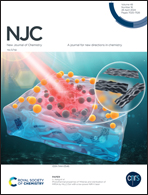Copper(ii) complexes of sterically hindered phenolic Schiff bases: synthesis, characterization, interaction with biomolecules, and antioxidant and antimicrobial activity†
Abstract
Schiff bases represent a class of biologically active and structurally diverse organic compounds that may be involved in copper(II) coordination as N,O-donor ligands. A redox-active biometal, copper is known to play a significant role in cellular metabolism and accounts for a wide range of biological activities exhibited by its compounds, namely antibacterial, antiproliferative, antifungal, antiinflammatory, etc. 4,6-Di-tert-butyl-2,3-dihydroxybenzaldehyde-derived Schiff bases and their Cu(II) complexes have been synthesized and characterized by means of FT-IR, UV-Vis, NMR and ESR spectroscopy, mass-spectrometry, elemental, XRD and thermogravimetric analysis, electrochemical measurements, quantum chemical calculations and molecular docking studies. The compounds were tested in vitro for antibacterial activity on Gram-positive and Gram-negative bacteria, bovine serum albumin and haemoglobin binding, as well as for hemolytic activity and for antioxidant activity in DPPH and ABTS assays. The synthesized ligands and their copper(II) complexes have been found to possess low cell toxicity and exhibit antioxidant activity higher than that of Trolox. Furthermore, several copper(II) complexes have demonstrated antibacterial activity comparable to those of tetracycline and streptomycin. The results obtained have been corroborated by molecular docking studies and interpreted in terms of the effects of copper(II) coordination by the organic ligand on radical-scavenging and bactericidal properties, protein affinity and toxicity of the latter.



 Please wait while we load your content...
Please wait while we load your content...